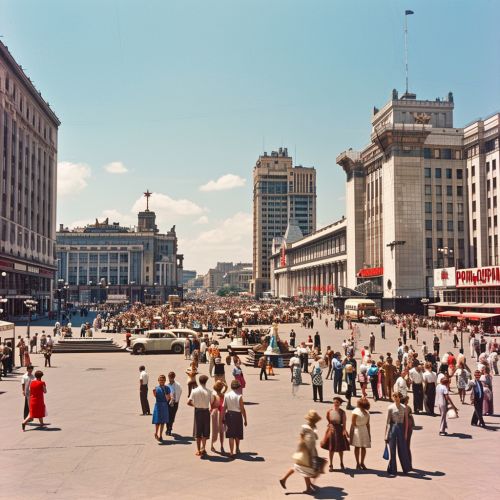Society of the Soviet Union
Society and Culture
The Soviet Union's society was characterized by a unique mix of ethnic diversity and socialist ideology. The country was home to over 100 different ethnic groups, each with its own unique culture and traditions. However, the overarching socialist ideology of the state sought to create a unified Soviet identity, often at the expense of these diverse cultures.


The Soviet Union was officially an atheist state, with religion being heavily suppressed. The Russian Orthodox Church, which had been the dominant religion in Russia prior to the revolution, was particularly targeted. Despite this, many people continued to practice their religions in secret, and some religious traditions were incorporated into state-sanctioned events.
Education was highly valued in Soviet society, with a strong emphasis on science and technology. The Soviet Union had one of the highest literacy rates in the world, and produced many world-renowned scientists and engineers. However, the education system was also used as a tool for political indoctrination, with students being taught the principles of Marxism-Leninism from a young age.
Economy
The economy of the Soviet Union was centrally planned and state-controlled. The State Planning Committee, or Gosplan, was responsible for setting production targets for all sectors of the economy. This system allowed the Soviet Union to rapidly industrialize and become a global superpower, but it also led to inefficiencies and shortages of consumer goods.
Agriculture in the Soviet Union was collectivized, with private farming being largely abolished. This led to a significant increase in agricultural production, but also resulted in widespread famine, particularly in the early years of collectivization.
Politics
The Soviet Union was a one-party state, with the Communist Party of the Soviet Union (CPSU) holding all political power. The CPSU was governed by a central committee, which was elected by party members. The General Secretary of the CPSU, a position held by leaders such as Joseph Stalin and Mikhail Gorbachev, was the de facto leader of the Soviet Union.
Despite the lack of political pluralism, there were significant political changes throughout the history of the Soviet Union. The period of Stalinism was characterized by political repression and totalitarian control, while the Khrushchev Thaw and Perestroika were periods of relative liberalization.
Demographics
The Soviet Union was one of the most ethnically diverse countries in the world, with over 100 different ethnic groups. The largest of these were the Russians, who made up over half of the population. Other significant ethnic groups included the Ukrainians, Uzbeks, and Kazakhs.
Despite this diversity, there was a strong emphasis on creating a unified Soviet identity. This was achieved through policies such as the promotion of the Russian language and the suppression of non-Russian cultures. However, these policies often led to ethnic tensions and conflicts.
Legacy
The legacy of the Soviet Union is complex and continues to be the subject of debate. On one hand, the Soviet Union was a global superpower that played a major role in shaping the 20th century. It made significant contributions to science and technology, and its policies of industrialization and collectivization transformed the economies of many regions.
On the other hand, the Soviet Union was also a totalitarian state that suppressed political dissent and violated human rights. Its policies led to widespread famine and economic hardship, and its collapse resulted in a period of economic and political instability in many former Soviet states.
